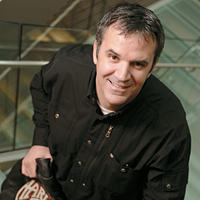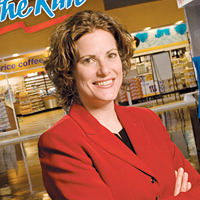| |
 |
| |
© Nathan Mandell
High-gear career: MMM allowed Matt Levatich '94 to shift
into a VP role at Harley-Davidson. |
| |
|
Success
by design
1 | 2
Focus
on technology
"A
broad knowledge of technologies and their applications is
something you wouldn't learn in a typical MBA program," explains
Vinayak Dravid, professor of material science and engineering
and director of the Atomic and Nanotech Characterization Experimental
Center at Northwestern.
In his
nanotechnology course, an elective in the MMM curriculum,
Dravid provides students with an overview of the subject,
explains the business model for nanotechnology startups, the
implications for intellectual property, and how technologies
influence ethics and society.
"Tomorrow's
leaders need to be aware of emerging technologies because
of their rapidly expanding role in business," says Dravid.
"Nanotechnology has the ability to impact all aspects of business.
It is a potentially disruptive technology with far-reaching
implications."
Professors
such as Dravid often provide learning experiences outside
the classroom as well as inside, when students form partnerships
with faculty by researching the commercial viability of technologies
they have developed, create business plans and even work with
the professors in start-up companies.
"We've
had a number of success stories in which either professors
or students have decided to start a company based on the student's
analysis of the commercial viability of their technology or
product," says Dravid.
For instance,
in 1998, MMM students Bill Fierle, Carlos Carbajal,
Dan Gordon, Eugene Ho, Nikhil Shah and
Peter Agnvall (all '98 grads) worked with mechanical
engineering professors Ed Colgate and Michael Peshkin to roll
out Cobotics Inc., a company that developed and marketed Intelligent
Assist Device technology for use in material handling applications.
Stanley Assembly Technologies acquired the company in 2003.
In 2004,
Dravid worked with MMM students Andreas Pecher, Praneet
Gupta, and Sam Mehta (all '05) to develop a business
plan for NanoSense, a nondestructive imaging product based
on a scanning near-field ultrasound holography method to image
elastic and visco-elastic variations across a sample surface
and reveal sub-surface features and defects critical in microelectronics
industries. The students themselves came close to starting
up a company with Dravid's technology, and Dravid is still
considering launching the company himself.
"Whether
or not actual companies are created at the end of these projects,
they are all successful from an educational standpoint in
terms of giving students the opportunity to solve real-world
problems," Dravid notes.
"Very
few programs give you the opportunity to do this kind of collaboration,"
says Hopp.
Students
who don't take on staff projects get real business experience
in the program's second year through the Integration Project,
in which students serve as consultants to leading manufacturing
companies or develop a business venture based on a new product.
Design
goes global
Classroom
experience is complemented with visits to domestic and overseas
manufacturing facilities, conferences and extracurricular
activities and clubs. Some plant visits are offered as formal
program activities while others are organized by students
themselves. In recent years, students have leveraged MMM connections
with industry to organize field excursions to nearby manufacturing
facilities such as Toyota and Illinois Tool Works.
As part
of the Kellogg School program, students also visit facilities
in China, Vietnam, India and South Africa through the Global
Initiatives in Management
(GIM) class, an intensive business leadership course designed
by students in close consultation with faculty advisers. Nearly
400 students typically participate in the annual course, a
challenging 10-week curriculum that culminates with a two-week
international field experience.
In March,
Karen Greig '06 participated in a GIM trip to India
led by Kellogg School Professor Bala
Balachandran and visited a number of locales, including
information technology companies Wipro and Infosys, HSBC Bank
and Tata Consultancy Services and Lucent Technologies' fledgling
Bell Labs.
 |
|
© James Kegley
"The perfect mix": Kim Matthews '04 added finance and
marketing to her manufacturing skills to run down a job
as ExxonMobil planning adviser.
|
|
| |
|
"The course
and the trip taught me a lot about how technology is flattening
the globe," says Greig. "Having worked and studied with many
Indians here in the U.S., it was wonderful to be able to visit
their country to see the diversity of culture and the complex
changes happening there. While tons of progress has been made
recently in many parts of the country, there's [still] so much
challenge and opportunity in India for business to take on...."
Matthew
Lippert '06 participated in a GIM trip to Brazil, where he
evaluated the factors behind the success of "Flex Fuel" vehicles,
which can run on any mix of ethanol or gasoline, learned about
the technology and manufacturing process, and evaluated their
applicability to other parts of the world.
"It was
really an excellent trip in that we were able to talk with
people from each of the affected parties: auto manufacturers,
oil and ethanol producers and government officials," he recalls.
"My project touched on a number of areas that are core to
the MMM program, such as innovation and manufacturing, but
also tied into the broader MBA curriculum."
Design
and innovation suggest future business landscape
Curriculum changes in the MMM program result from market
changes, student demand, and insights from a 35-member advisory
board which meets twice a year with faculty and students.
"The program's
academic focus has shifted over its 15 years," says Hopp.
"In the early '90s, we emphasized the importance of quality.
In the later '90s, emphasis shifted to supply chain management.
Today, business is focused on innovation and new product design,
so we are revising the curriculum."
This spring
will mark the first MMM conference on innovation, which will
be added on to the annual Kellogg Manufacturing
Business Conference. Hopp plans to invite leading-edge
companies to provide details about how they are managing and
accelerating innovation.
"Another
thing we're now working on is growing and developing our New
Product Innovation course," says Hopp. "Last year, we
began focusing the course on one market space, such as the
airline industry, within which students explore opportunities
and actually create products."
Craig
Sampson, health practice lead for global design consultancy
IDEO and an adviser and key lecturer in the New Product
Innovation course, sees this as a valuable approach.
"When
students focus their research and design efforts on a particular
opportunity space, there is more collaboration and a cohesive
body of knowledge begins to develop, resulting in richer solutions,"
explains Sampson.
"All students
who go through New Product Innovation get a glimpse
of what it takes to design products and to be truly innovative,"
he adds. Team-based, multi-disciplinary innovation may be
the most important thing students learn from the program,
he believes.
"MMM is
unique in that it brings together students with diverse technical
and business experiences from the world today. We build on
that foundation to help them understand relationships between
technology, business and human needs. There are very few places
where those three bodies of knowledge come together, but that's
where innovation happens," says Sampson.
One outstanding
trait that MMM students demonstrate is an understanding of
what it takes to design and build a product, Sampson notes.
"Just like teams at IDEO, we have student teams embrace a
culture of prototyping to quickly iterate all the way from
needs identification to designing for manufacturing," he says.
"When done well, we are not just designing products, but designing
the future."
A MMM
education often enhances students' internship and job opportunities
in product-oriented companies. The program gives students
career flexibility that opens up rewarding options within
a broad range of functions, including finance, marketing,
operations, general management and consulting.
"MMM grads
use their manufacturing background to bridge the divide between
a venture's business side and its engineering side," says
Hopp. For example, they understand the implications of a marketing
strategy and can talk to the engineers on the factory floor
in a way someone without that knowledge would find difficult
or impossible.
"This
combination of breadth and depth gives MMM grads enormous
power and trust in their jobs," says Hopp, "and is an approach
garnering growing attention from industry leaders."
Greig
is one student already benefiting from her MMM experience.
"My summer
internship as a project manager at Motorola in its Customer
Center for Solutions Integration was a job I received due
to my pursuing engineering management as well as business
administration," says Greig. "By the time I graduate, I know
that the contacts and education I have received from both
schools will help me find a career that balances technology
and business - and which will put me at the cutting edge of
thought that will drive future innovation."
|



